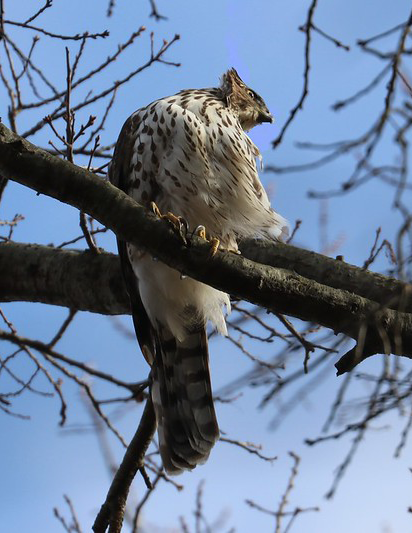On the Move: Catch the Hawks and Songbirds Heading South

By Brian Kluepfel
In my opinion autumn is the most beautiful season. Not for me, the icy winter winds nor the summer’s oppressive heat and humidity. Not even spring’s allergy-inducing flowers! Give me the slow, resplendent dying of a New England autumn anytime.
Of course, for birders in the Northeast, it’s a special time too. After an often-desultory summer (once the nestlings have fledged), we are treated to the reverse of the spring migration, as colorful songbirds head to their wintering grounds in the Caribbean and Central and South America. It’s a chance not to be missed, and it’s recommended you get out there and catch it during September and October.
Lesser known, but just as spectacular, is the seasonal migration of raptors, happening right now. Because of its unique positioning near the Long Island Sound, this area is rich with birds of prey funneling inland on the warmer air above our land mass. Sometimes thousands of hawks can pass in a single day, and true aerial spectacles are within mere miles of where we live.
Our sister chapter, Bedford Audubon, hosts a hawk watch high above Route I-684 in Butler Sanctuary, a Nature Conservancy property, in Bedford, just east of Mount Kisco. They’ve even built special bleachers for raptor fans.
Tait Johansson leads the efforts at Chestnut Ridge, where various forms of soaring, sliding, kiting and hovering are undertaken by accipiters (Coopers and sharp-shinned hawks and the occasional goshawk), the chunkier buteos (red-tailed, red-shouldered and broad-winged hawks) and even some eagles. Johansson said in a recent Audubon Zoom chat that getting used to counting these various species involves “being wrong a lot of times.” So, no pressure, folks. There are usually some experienced birders up there to guide you.
Another great site is just across the bridge at Nyack’s Hook Mountain. Judy Battally and Drew Panko have been tallying red-tails and others for decades. Although counts were at record lows for many birds here in 2019, the duo are optimistic that 2020 could turn things around. Counting has been done at Hook Mountain since 1971, and progress in nature is often measured in decades, not years.
The excitement of Hook is some birds flying by at eye-level – near enough where you sometimes feel they will collide with your camera or binoculars.
Meanwhile, just across the border in Greenwich, Sharon Bruce and Ryan MacLean rally the tally troops at Quaker Ridge, which has also been a hawk-watching pilgrimage (Dare I say “peregrination?”) since the 1970s. Since the ridge line there tends to create uplift and thermals, meaning migrating hawks are free to glide without expending energy, this is also an amazing vantage point to spy these birds of prey.
And don’t forget, folks, the garbage scows of the sky, the scavenging birds of prey we call vultures. International Vulture Awareness Day was Sept. 5, and we have to remember the important role these birds play in the cleanup of our environment, including the reduced spread of disease. So even though they may not be the best-looking birds, give some respect to our local species, the turkey vulture and the black vulture.
Here is information on local hawk watches:
Hook Mountain: http://www.battaly.com/hook/directions.htm
Chestnut Ridge: https://bedfordaudubon.org/chestnut-ridge-hawkwatch/
Quaker Ridge: https://greenwich.audubon.org/quaker-ridge-hawk-watch
Saw Mill River Audubon: https://www.sawmillriveraudubon.org/
Please remember to support Saw Mill River Audubon’s annual seed sale this weekend. Stock up on your supply for the winter.
Brian Kluepfel is a guidebook author for Lonely Planet and has written for Birdwatching Magazine as well as Westchester Magazine, Guitar Player and The Irish Herald. He loves to watch the ospreys fly over the Hudson. He is a proud member of Saw Mill River Audubon and encourages anyone to join.

